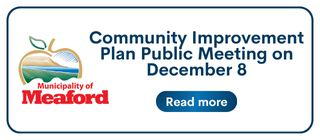By Stephen Vance, Editor
 Before anyone gets their knickers in a knot after hearing that Meaford is heading for significant shortfalls in funding for municipal infrastructure repair and replacement in the not too distant future, it should first be noted that Meaford is far from alone in this predicament.
Before anyone gets their knickers in a knot after hearing that Meaford is heading for significant shortfalls in funding for municipal infrastructure repair and replacement in the not too distant future, it should first be noted that Meaford is far from alone in this predicament.
For many years municipal governments across North America have been warned that the glory days are over, and that an infrastructure doomsday in approaching.
The problem isn’t that municipalities have been ignoring the warnings, in Canada at least, the issue is that municipalities have very limited sources from which to draw funding, leaving most municipalities severely handicapped when considering their infrastructure replacement needs.
In September of last year a ‘Canadian Infrastructure Report Card’ was released jointly by the Canadian Society for Civil Engineering, the Canadian Public Works Association, the Canadian Construction Association, and the Federation of Canadian Municipalities, and what was contained in that report was distressing to say the least.
The report found that, on average, about 30 percent of Canada’s municipal infrastructure ranked between ‘fair’ and ‘very poor’, and the replacement cost for that municipal infrastructure is a whopping $178 billion nationally.
Anyone who has driven a car is well aware of the most obvious deficiency – roads. According to the report card more than half of the municipal roads in Canada score below the ranking of ‘good’, and more than 20 percent are ranked ‘very poor’.
“The estimated replacement cost of the roads in fair to very poor condition is $91.1 billion, nationally. For the average Canadian household, this amounts to a cost of $7,325,” read the report – and that is just for the worst of the worst roads.
If that wasn’t bad enough, the report also found that about 40 percent of waste-water plants, pumping stations, and storage tanks were ranked ‘fair’ to ‘very poor’, as were roughly 30 percent of municipal pipes.
The replacement cost for the waste-water infrastructure ranked ‘fair’ or lower amounts to an estimated $39 billion, or $3,136 per household.
If you’re keeping count, your own household is already on the hook for $10,461 – but don’t put away your calculator just yet, it gets worse.
While the drinking-water infrastructure in Canadian municipalities is in pretty good shape when compared to roads and waste-water infrastructure, the estimated cost per Canadian household for replacement of drinking-water infrastructure scoring below ‘fair’ is another $2,082, and the report estimates another $1,270 per Canadian household to replace sub-par storm-water management systems.
That brings our total per-household infrastructure liability to a stunning $13,813 – and that’s just for what is sub-standard at this moment.
Feel like complaining about your property tax levels now?
It really makes me wonder how anyone can suggest that municipal governments restrict property tax increases to zero, or even more alarming, some suggest that municipal governments need to cut property tax rates.
There’s no free ride, and unfortunately our civilization has created a society that is quite possibly unsustainable from an infrastructure perspective.
You know those granola-crunching lefties that some like to scoff at when they use words like ‘sustainable’? Funny thing about those Birkenstock-wearing hippie types, they are most often right when they sound the alarm bells, though typically their warnings aren’t heeded until it is too late.
It is uncertain where the money is going to come from in order to solve the infrastructure problem, but don’t be fooled by the word ‘grant’. I often hear people suggest that municipalities should do a better job of seeking federal and provincial grants for things like infrastructure projects as if it comes from some magical place, and not from just another pocket in your same pair of pants.
However the coming infrastructure nightmare is dealt with, all Canadians need to begin applying pressure on all levels of government to work jointly on a solution, though I would propose that before begging upper levels of government to open the floodgates to coffers that will no doubt be filled with borrowed money, we take a page from the book of the much-scoffed-at hippie types… let’s finally admit that we have too much, much more than we need, and begin to look at scaling back.
Even if all the sub-standard infrastructure was magically fixed tomorrow, it won’t take long before the infrastructure that currently ranks as ‘good’ begins falling apart, and we’ll be back in the same boat.
Sustainability is more than a catch-phrase: it should be at the core of every decision governments – and those who elect them – make.










